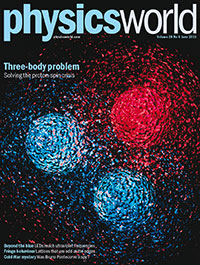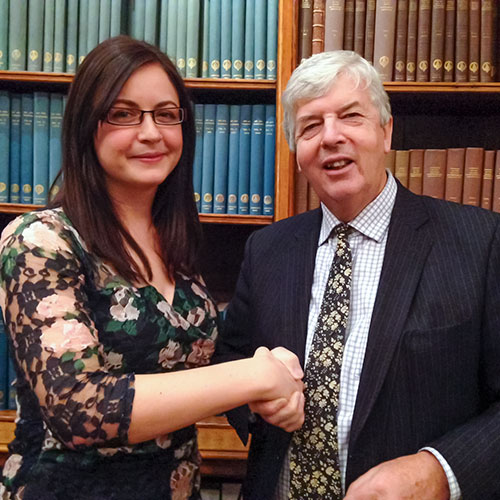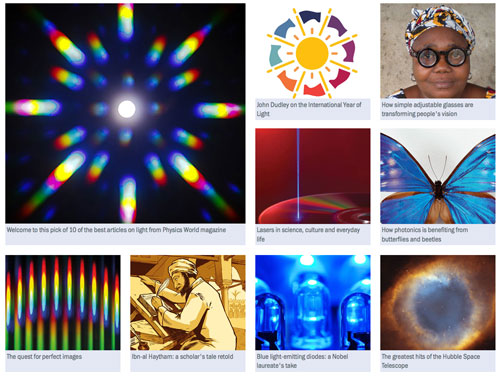Tag archives: Physics World magazine
The July 2015 issue of Physics World is now out
By Matin Durrani
Sometimes, nature does something unexpected – something so rare, transient or remote that only a lucky few of us get to see it in our lifetimes. In the July issue of Physics World, we reveal the physics behind our pick of the weirdest natural phenomena on our planet, from dramatic rogue waves up to 30 m tall, to volcanic lightning that can be heard “whistling” from the other side of the world, and even giant stones that move while no-one is watching. We also tackle tidal bores on rivers and the odd “green flash” that is sometimes seen at sunset.
Plus, we’ve got six fabulous full-page images of a range of weird phenomena, including salt-flat mirrors, firenadoes, “ice towers”, beautifully coloured nacreous clouds, mysterious ice bubbles of gas trapped in columns, as well as my favourite – the delicately wonderful “frost flowers” seen very occasionally on plants.
The June 2015 issue of Physics World is now out
By Matin Durrani
For nearly three decades, physicists have been unable to answer a seemingly simple question: where does proton spin come from? Adding up the spins of the three quarks that make up the proton seems, in principle, straightforward, but physicists have been struggling with a strange problem: the sum of the spins of its three quarks is much less than the spin of the proton itself.

Known as the “spin crisis”, the topic appears as the cover story of the June 2015 issue of Physics World, which is out now in print and digital formats. In the feature article, science writer Edwin Cartlidge examines the origins of the problem – and whether new experiments could mean we are about to solve it at last.
If you’re a member of the Institute of Physics (IOP), you can get immediate access to the feature with the digital edition of the magazine on your desktop via MyIOP.org or on any iOS or Android smartphone or tablet via the Physics World app, available from the App Store and Google Play. If you’re not yet in the IOP, you can join as an IOPimember for just £15, €20 or $25 a year to get full digital access to Physics World.
The issue also includes a great Lateral Thoughts article by Felix Flicker that’ll have you twisting and bending your arms as you try to follow what he’s on about.
View all posts by this author | View this author's profile
Inside Mexico’s giant centre of learning
By Matin Durrani in Mexico City
It’s one of the biggest universities in the world with several hundred thousand students, but the Universidad Nacional Autonóma de México (UNAM) is certainly not the oldest. In fact, the first person to get a degree and PhD in physics at UNAM – Fernando Alba – is still alive. Aged 95, he studied at UNAM’s Institute of Physics shortly after it opened its doors in 1939.
Physics World visit to Mexico kicks off
By Matin Durrani in Mexico City
I don’t know about you, but my trick whenever flying halfway across the world is to shoehorn myself as fast as possible into the new time zone I’m in. Having travelled from the UK to Mexico City with my colleague James Dacey yesterday, that tactic seems to have worked…so far. After staying up till midnight following a mini-feast of fabulous spicy tacos at a nearby restaurant while a thunderstorm broke, I woke up on cue at 7 a.m. as dawn broke in one of the biggest urban areas in the world.
We’re both here to gather material for a Physics World special report on physics in Mexico, which is due out in September. Following fast on the heels of recent reports on India, Brazil, Korea, India (again), Japan and China, the report will shine a light on some of the exciting physics research going on in the country and highlight some of the challenges and opportunities the country’s physicists face, too.
The May 2015 issue of Physics World is now out
By Matin Durrani
A couple of years back, I had the pleasure of travelling 1100 metres below ground to visit a dark-matter laboratory at the bottom of the Boulby Mine on the north-east coast of England. The journey was certainly memorable – it involved plunging down in a rattling lift cage for several minutes with a group of miners setting off on their morning shift. Once in the lab – housed inside a souped-up set of trailers – I interviewed physicist Sean Paling about the experimental projects going on there.
Setting up an underground lab, like that at Boulby, certainly doesn’t come cheap and in recent years, many have started to diversify into new areas. In the May issue of Physics World, which is now out in print and digital formats, Paling and his colleague Stephen Sadler – who is director at DURRIDGE UK Radon Instrumentation – describe the renaissance in the science taking place far beneath our feet. Studies in underground labs now range from Mars rovers to muon tomography and from radioactive dating to astrobiology.
Five amazing physics demonstrations
By Matin Durrani
Even if you’re a hardcore theoretical physicist, I’m sure you’ll agree that experiments are the lifeblood of physics. After all, theory and experiment go hand in hand – and there’s nothing to beat getting your hands dirty to get a proper understanding of the subject.
But how can pupils and students get excited about experiments? Making practical work a key part of exam syllabuses is surely important – yet the danger then is experimental work becomes a chore not a charm.
If you need inspiration, check out the April issue of Physics World magazine, which is now out in print and digital formats. It contains a great feature by Neil Downie – head of sensors at Air Products, Basingstoke, Hampshire, UK and a Royal Academy of Engineering visiting professor at the University of Surrey.
View all posts by this author | View this author's profile
Your secret superpower
By Matin Durrani
The March 2015 issue of Physics World magazine, a special issue about light in our lives that is now out in print, online and via our apps, contains a fascinating feature about an astonishing – and largely unknown – superpower that you perhaps don’t realize you have. It might sound bizarre, but using your naked eyes – and with no additional gadgets whatsoever – you can detect whether or not light is “polarized”. And in the video above, Louise Mayor, features editor of Physics World, tells you how.
Louise Mayor bags European astronomy journalism prize

Andrew Taylor of the Science and Technology Facilities Council congratulates Louise Mayor on winning the European Astronomy Journalism Prize 2014. (Courtesy: ESO/STFC)
By Matin Durrani
If you think that writing a great feature article about physics is easy, think again. You want something that’s pitched at the right level for the audience. You’ve got to avoid jargon and explain technical terms where necessary. You can’t go on and on – you’re not trying to rewrite Wikipedia.
Most importantly, you need to tell a good story and say something new, different and intriguing. And remember, your readers could switch off at any point, so the article has to be well written, flow well from point to point, have plenty of colour and, ideally, have some pay-off or punch-line at the end. No point just trailing off into nothingness. Oh, and good pictures, headlines and captions are a must.
So I’m sure you’ll join me in congratulating my colleague Louise Mayor – features editor of Physics World magazine – who has won this year’s European Astronomy Journalism Prize for an article she wrote for the October 2014 edition of the magazine. Her winning article is entitled “Hunting gravitational waves using pulsars” and looks at efforts to detect gravitational waves using radio telescopes to observe distant pulsars.
The February 2015 issue of Physics World magazine is now out
By Matin Durrani
It’s now more than 40 years since the last person set foot on the Moon, but since then we’ve come to realize that the lunar surface is not only home to plenty of rare-earth elements, such as lanthanum and neodynium, but also to more than a billion tonnes of water-ice at the poles. Several US firms in fact have bold plans to mine those resources, as the cover story of the February issue of Physics World magazine makes clear.
One idea is to electrolyse the water into hydrogen and oxygen that could be used as a fuel source for operations on the Moon. Even more boldly, the water ice could be shipped to low Earth orbit, where it could be used to fuel space craft sent up from Earth. To find out more about whether those plans are realistic, do check out the February issue, which is now out online and through our app.
View all posts by this author | View this author's profile
Enjoy 10 of the best Physics World articles on light

Celebrating IYL 2015 with a special free-to-read digital edition of Physics World.
By Matin Durrani
The International Year of Light (IYL 2015), which officially launches today at the headquarters of the UN Educational, Scientific and Cultural Organization (UNESCO) in Paris, is a brilliant initiative, but if you’re wondering how to find out more about the science and applications of light, then I’ve got the perfect place for you to start.
That’s because Physics World magazine is launching today a great, free-to-read digital edition containing 10 of our very best feature articles on the science and applications of light.